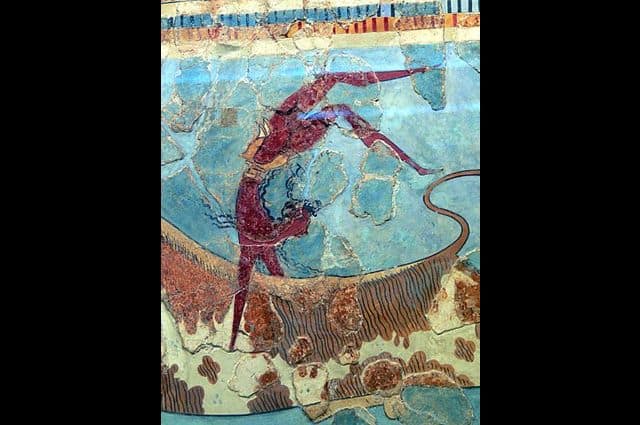
Cretan fresco of a man leaping over a bull.
An acrobat is a performer who specializes in performing acrobatics and jumps . The term comes from the Italian word saltimbanchi .
Acrobatic show
The term is generally used to refer to someone who performs an acrobatic show in a park or other open-air space. Acrobats were popular in the Middle Ages , sharing characteristics with acrobats , tightrope walkers and minstrels .
Medieval acrobats often jumped on trapezes or swings . They could also balance on stilts and walk on a wheel .
Today, acrobats still use acrobatics and stunts to entertain audiences . They usually wear colorful costumes and work in circuses , although they can also work as street performers .
Theatrical work
“Saltimbanquis” , on the other hand, is the title of a play produced in Argentina . It is a children’s musical inspired by “The Town Musicians of Bremen” , a tale by the Grimm brothers .
In “Saltimbanquis” , four animals get tired of being exploited by humans, run away from their masters and form a musical group. The work , which has music by Luis Bacalov and a book by Sergio Bardotti , was awarded two Hugo Awards and an ACE Award , among other recognitions.
Bullfighters of Knossos
In the field of art we find various graphic representations of the figure of the acrobat. Such is the case of a fresco found near the city of Knossos , located in the northern part of the island of Crete, in which we can see a man performing a spectacular jump to go from one side to the other of a bull, using its back to support himself and push himself to finish the movement.
The protagonist of this painting belongs to the so-called Minoan civilization , the oldest of the Copper and Bronze Ages . Note that in some sources, we find the adjectives Minoan or Cretan as synonyms of Minoan . It is found in the group of Aegean civilizations , where we find the pre-Hellenic ones that originated between prehistory and ancient history near the Aegean Sea.
Picasso's Comedians
There is a work entitled Suite des Saltimbanquis , which brings together a series of creations by the painter and sculptor from Malaga, Pablo Picasso . In it we can find a large number of different characters belonging to the so-called commedia dell'arte , a variety of popular theatre that emerged in the mid-16th century in Italy and continued until the beginning of the 19th century.
In the Suite des Saltimbanques we find a contradiction between the character of the world depicted in Picasso's works and the vision given to them, which could be considered poetic. We have some paintings, such as The Acrobat's Wife and The Saltimbanquis' Family , from his Rose Period (the second stage of his artistic career), which are combined with some sculptures, such as The Jester (made of bronze and also called The Fool , it is the head of a man with a harlequin's cap) and his portraits of pierrots, punchinelles and harlequins, where there are some outstanding portraits of his sons Claude and Paulo.

Pablo Picasso's work includes various representations of the acrobat.
Other uses
Saltimbanqui , on the other hand, is the name of a Salesian social circus born in the province of Córdoba ( Argentina ). Its objective is to promote social transformation with young people as agents of change. It is an initiative that supports the most important part of society, which sometimes does not receive the attention it should.
Saltimbanqui , finally, is an entity based in Cartagena ( Spain ) that develops actions in the field of children's entertainment and non-formal education . It was founded in 2014 .
